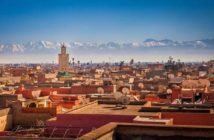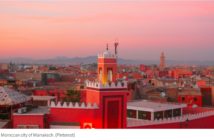Telegraph.co.uk – TRAVEL
The only short-haul destination that’s hot into October, Morocco’s desert city mixes ancient souks and cutting-edge couture, says Alison Bing.
Summer has ended everywhere but Marrakesh, where conjurers, acrobats, trained monkeys, snake charmers, musicians and storytellers descend on the Djemaa el-Fna market place at sunset, well into the balmy nights of October. You too can enter the epic tale of this much-storied, 1,000-year-old trading post. Marrakesh’s Medina (old city) is now a Unesco World Heritage site and its souks (markets) have an enduring appeal. Trans-Saharan camel treks are no longer necessary to get here. Low-cost flights at off-peak autumn rates will land you in a graceful riad (traditional courtyard guesthouse) in hours.
Where to stay
Special treat: Jnane Tamsna is in a secluded nine-hectare estate 20 minutes drive from the Medina, traffic permitting. It has chiselled good looks in cream stucco and dark wood. Doubles from £210.
Jnane Tamsna offers understated luxury for a good price
Mid-range: The cleverly designed Riad Al Massarah hotel (1) compares favourably with other boutique hotels – all easy charm and fine dining. It is located near the Bab Doukkala gate and a wonderful food souk. Doubles from £100.
On a budget: The Maison Mnabha (2) is a gem tucked deep in a pocket of the royal Kasbah, for less than a carpet you’d haggle over in the souk. Doubles from £64.
These hotels, and my other recommendations of where to stay, can be booked attelegraph.co.uk/marrakeshhotels, which offers a best-price guarantee.
Getting there
EasyJet (0905 821 8905; easyjet.com), flies to Marrakech from Gatwick and Manchester; Ryanair (0871 246 0000; ryanair.com) operates from Luton and London Stansted; Thomson (0871 231 4787;thomsonfly.com) from Birmingham, Gatwick and Manchester; and British Airways (0844 493 0787; ba.com) from Heathrow and Gatwick.
To reach accommodation in the labyrinthine Medina, arrange door-to-door transfers (£12 to £18) in advance through your guest house or hotel.
On arrival
Once you are comfortably settled, follow the crowd inexorably toward the magnetic Djemaa el-Fna (3).
5pm
Around sunset, no opera box seat is as coveted as a plastic chair at the Café du Grand Balcon(northwest corner, Djemaa el-Fna). Acrobats flip past and Gnawa musicians clang castanets as though to raise the dead, while the unflappable waiters pour gallons of mint tea into tiny glasses without spilling a drop.

6.30pm
Savoury steam wafts from cauldrons of stewed snails on Djemaa el-Fna, but those with adventurous appetites hold out until 100 makeshift barbecue stalls start serving surprisingly appetising teyhan (spleen) kebabs. For those with more reserved palates, vegetarian couscous at Chez Chegrouni (northeast corner) is a tasty alternative, with ringside views of the Djemaa el-Fna action.
8pm
In-flight kinks quickly dissolve in a hammam (steam bath) at Le Bain Bleu (4). Opt for a soothing orange-blossom oil massage (from £26/h), or feel your soft skin tingle with a brisk full-body gommage (scrub; from £11).
Day one
10am
Marrakesh gets by on its wits, but it also has baraka (divine grace) to spare. The city’s seven saints’ shrines are closed to non-Muslims, but Ali Ben Youssef Medersa (5) is an important 14th-century centre of Islamic learning, open to all as a museum. Students’ quarters ring a serene courtyard graced with iridescent zellij (puzzle-piece mosaics) and cedar balconies.
11am
In the palm-roofed souks, artisans’ studios are arranged by arcane logic. Follow the chorus of iron hammers to find ornate lanterns in Haddadine (Metalworkers’) Souk; the aroma of leather to the gilded poufs on offer in Cherratine (Leatherworkers’) Souk; and your tastebuds to towers of 37-spice blends in Rahba Kedima (6), the old spice market.

Happily, some things change: Coopérative Artisanale des Femmes de Marrakesh is a women’s collective charging fixed prices for its creations, from polka-dotted Pop art kaftans to fragrant orangewood trays.
1pm
Emerge under the canopy of saffron wool inSebbaghine (Dyers’) Souk, and flop on a divan at Villa Flore (villa-flore.com) for lunch (from £16; dinner from £24). Try chef Mustapha Benacher’s aubergine caviar, washed down with Moroccan Medallion Rosé of Syrah.
3pm
Beat a retreat to Jardin Majorelle (7), enchanted garden of designer Yves Saint Laurent in the Ville Nouvelle (new city). Jacques Majorelle’s cobalt blue, lemon yellow and oxidised copper green are great for photos amid rare African cacti.
5pm
Marrakesh is the home of Morocco’s first fine arts school and cutting-edge art galleries, clustered in the Ville Nouvelle. Graffiti meets Berber at David Bloch Gallery (davidblochgallery.com) and Galerie Noir Sur Blanc (facebook.com/galerie.noirsurblanc), while Galerie Rê (galeriere.com) and Matisse Art Gallery (matisseartgallery.com) display more abstract art.
Gallery-hop down Rue des Vieux Marrakchis, where modern couture is hot off the racks at Moor (akbardelights.com) and Michèle Baconnier (michele-baconnier.fr). Window-shop along Rue de la Liberté to Kechmara (kechmara.com) to join sunset happy hour on the canopied roof terrace.
8pm
At nearby Al Fassia (00 212 524 43 40 60; mains from £11; booking essential), a parade of 11 salads and dips is only the first course – a proper Moroccan diffa (feast) has four more courses. The owner Saida Chab and her sisters mercifully offer à la carte versions of signature dishes: caramelised pumpkin tagine, cinnamon-dusted bastilla (pigeon pie), and tender lamb roasted so slowly it must be ordered 24 hours in advance.
10.30pm
At Le Comptoir bar, Olympians flirt with mere mortals, and ambassadors risk their diplomatic credentials with the belly dancers. The fun peaks at midnight, when strategically spangled dancers descend staircases balancing trays of lit candles on their heads.
Day two
10am
Last-minute laps of the souks are tempting, but visiting the Saadian Tombs (8) (Rue de la Kasbah, £1) is a reminder that you can’t take it all with you.

Saadian Sultan Ahmed built family mausoleums dripping with muqarnas (honeycomb stucco). But his glory didn’t last long: his successors sealed the tombs, which were only rediscovered in 1917.
12pm
Hand gestures and £5 will procure a legendary lunch: mechoui, or lamb slow-roasted in hot ashes. At noon in the Ablueh (Olive-sellers’) Souk, find a counter adorned with a sheep’s head, and point to your preferred cut of lamb.






